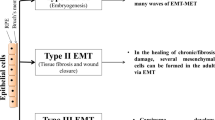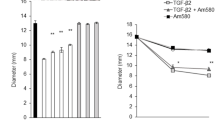Abstract
This study assessed the role of mechanistic target of rapamycin (mTOR) pathway in the human adult retinal pigment epithelial (ARPE) cell response after laser photocoagulation (LP). The effect of mTOR inhibition on ARPE-19 cell was investigated by rapamycin treatment after LP. Cell viability and proliferation were explored using MTT and EdU assays, respectively. The expression of mTOR-related proteins and epithelial-mesenchymal transition (EMT) markers was verified by Western blot. Rapamycin retarded the LP area recovery in a dose-dependent manner by the 120 h, while LP+DMSO vehicle-treated cells completely restored the lesion zone (P ≤ 0.01). ARPE-19 cell viability is significantly lower in LP + rapamycin 80 and 160 ng/ml treated cultures compared to LP control at 120 h (P ≤ 0.001). LP control group demonstrated significantly more proliferative cells compared to untreated cells at the 72 and 120 h, whereas EdU-positive cell numbers in cultures treated with rapamycin at concentrations of 80 and 160 ng/ml were similar to baseline values (P ≤ 0.01). mTOR pathway activation is essential for regulation of the RPE cell migration and proliferation after LP. mTOR inhibition with rapamycin effectively blocks the migration and proliferation of the RPE cells. Our results demonstrate that mTOR has an important role in ARPE-19 cell as a regulator of cell behavior under stress conditions, suggesting that mTOR could be a promising therapeutic target for numerous retinal diseases.





Similar content being viewed by others
References
Diabetic Retinopathy Study Research Group (1978) Photocoagulation treatment of proliferative diabetic retinopathy: The second report of diabetic retinopathy study findings. Ophthalmology 85:82–106. https://doi.org/10.1016/S0161-6420(78)35693-1
Early Treatment Diabetic Retinopathy Study research group (1987) Treatment techniques and clinical guidelines for photocoagulation of diabetic macular edema. Early Treatment Diabetic Retinopathy Study report number 2. Ophthalmology 94:761–774
Good WV, Early Treatment for Retinopathy of Prematurity Cooperative Group (2004) Final results of the Early Treatment for Retinopathy of Prematurity (ETROP) randomized trial. Trans Am Ophthalmol Soc 102:233–248 discussion 248–50
Priebe LA, Cain CP, Welch AJ (1975) Temperature rise required for production of minimal lesions in the Macaca mulatta retina. Am J Ophthalmol 79:405–413. https://doi.org/10.1016/0002-9394(75)90613-3
Tababat-Khani P, Berglund LM, Agardh CD, Gomez MF, Agardh E (2013) Photocoagulation of human retinal pigment epithelial cells in vitro: evaluation of necrosis, apoptosis, cell migration, cell proliferation and expression of tissue repairing and cytoprotective genes. PLoS One 8(8):e70465. https://doi.org/10.1371/journal.pone.0070465
Campochiaro PA (2000) Retinal and choroidal neovascularization. J Cell Physiol 184:301–310. https://doi.org/10.1002/1097-4652(200009)184:3<301::AID-JCP3>3.0.CO;2-H
Duh EJ, Yang HS, Haller JA, De Juan E, Humayun MS, Gehlbach P, Melia M et al (2004) Vitreous levels of pigment epithelium-derived factor and vascular endothelial growth factor: implications for ocular angiogenesis. Am J Ophthalmol 137(4):668–674. https://doi.org/10.1016/j.ajo.2003.11.015
Strauss O (2005) The retinal pigment epithelium in visual function. Physiol Rev 85(3):845–881. https://doi.org/10.1152/physrev.00021.2004
Sparrrow JR, Hicks D, Hamel CP (2010) The retinal pigment epithelium in health and disease. Curr Mol Med 10(9):802–823. https://doi.org/10.2174/156652410793937813
Muether PS, Neuhann I, Buhl C, Hermann MM, Kirchhof B, Fauser S (2013) Intraocular growth factors and cytokines in patients with dry and neovascular age-related macular degeneration. Retina 33(9):1809–1814. https://doi.org/10.1097/IAE.0b013e318285cd9e
Kernt M, Neubauer AS, Liegl RG, Hirneiss C, Alge CS, Wolf A, Ulbig MW, Kampik A (2010) Sorafenib prevents human retinal pigment epithelium cells from light-induced overexpression of VEGF, PDGF and PlGF. Br J Ophthalmol 94(11):1533–1539. https://doi.org/10.1136/bjo.2010.182162
Hattenbach LO, Beck KF, Pfeilschifter J, Koch F, Ohrloff C, Schacke W (2005) Pigment-epithelium-derived factor is upregulated in photocoagulated human retinal pigment epithelial cells. Ophthalmic Res 37(6):341–346. https://doi.org/10.1159/000088263
Polivka J Jr, Janku F (2014) Molecular targets for cancer therapy in the PI3K/AKT/mTOR pathway. Pharmacol Ther 142(2):164–175. https://doi.org/10.1016/j.pharmthera.2013.12.004
Kim YC, Guan KL (2015) mTOR: a pharmacologic target for autophagy regulation. J Clin Invest 125(1):25–32. https://doi.org/10.1172/JCI73939
Perl A (2015) mTOR activation is a biomarker and a central pathway to autoimmune disorders, cancer, obesity, and aging. Ann N Y Acad Sci 1346(1):33–44. https://doi.org/10.1111/nyas.12756
Johnson SC, Rabinovitch PS, Kaeberlein M (2013) mTOR is a key modulator of ageing and age-related disease. Nature 493(7432):338–345. https://doi.org/10.1038/nature11861
Laplante M, Sabatini DM (2012) mTOR signaling in growth control and disease. Cell 149(2):274–293. https://doi.org/10.1016/j.cell.2012.03.017
Jing L, Sang GK, Blenis J (2014) Rapamycin: one drug, many effects. Cell Metab 19(3):373–379. https://doi.org/10.1016/j.cmet.2014.01.001
Zhao C, Vollrath D (2011) mTOR pathway activation in age-related retinal disease. Aging (Albany NY) 3(4):346–347. https://doi.org/10.18632/aging.100303
Jacot JL, Sherris D (2011) Potential therapeutic roles for inhibition of the PI3K/Akt/mTOR pathway in the pathophysiology of diabetic retinopathy. J Ophthalmol 2011:589813
Yagasaki R, Nakahara T, Ushikubo H, Mori A, Sakamoto K, Ishii K (2014) Anti-angiogenic effects of mammalian target of rapamycin inhibitors in a mouse model of oxygen-induced retinopathy. Biol Pharm Bull 37(11):1838–1842. https://doi.org/10.1248/bpb.b14-00487
Çakmak H, Ergin K, Bozkurt G, Kocatürk T, Evliçoğlu GE (2016) The effects of topical everolimus and sunitinib on corneal neovascularization. Cutan Ocul Toxicol 35(2):97–103
Faghiri Z, Bazan NG (2010) PI3K/Akt and mTOR/p70S6K pathways mediate neuroprotectin D1-induced retinal pigment epithelial cell survival during oxidative stress-induced apoptosis. Exp Eye Res 90(6):718–725 https://doi.org/10.1016/j.exer.2010.03.002
Dunn KC, Aotaki-Keen AE, Putkey FR, Hjelmeland LM (1996) ARPE-19, a human retinal pigment epithelial cell line with differentiated properties. Exp Eye Res 62:155–169. https://doi.org/10.1006/exer.1996.0020
Hamel CP, Tsilou E, Pfeffer BA, Hooks JJ, Detrick B, Redmond TM (1993) Molecular cloning and expression of RPE65, a novel retinal pigment epithelium-specific microsomal protein that is post-transcriptionally regulated in vitro. J Biol Chem 268:15751–15757
Finnemann SC, Bonilha VL, Marmorstein AD, RodriguezBoulan E (1997) Phagocytosis of rod outer segments by retinal pigment epithelial cells requires alpha(v)beta5 integrin for binding but not for internalization. Proc Natl Acad Sci U S A 94:12932–12937. https://doi.org/10.1073/pnas.94.24.12932
Park TK, Lee SH, Choi JS, Nah SK, Kim HJ, Park HY, Lee H, Lee SHS, Park K (2017) Adeno-associated viral vector-mediated mTOR inhibition by short hairpin RNA suppresses laser-induced choroidal neovascularization. Mol Ther Nucleic Acids 8:26–35. https://doi.org/10.1016/j.omtn.2017.05.012
Oh JR, Han JW, Kim YK, Ohn YH, Park TK (2017) The effects of anti-vascular endothelial growth factor agents on human retinal pigment epithelial cells under high glucose conditions. Int J Ophthalmol 10(2):203–210
Zong H, Yin B, Zhou H, Cai D, Ma B, Xiang Y (2014) Inhibition of mTOR pathway attenuates migration and invasion of gallbladder cancer via EMT inhibition. Mol Biol Rep 41(7):4507–4512. https://doi.org/10.1007/s11033-014-3321-4
Han B, Cui H, Kang L, Zhang X, Jin Z, Lu L, Fan Z (2015) Metformin inhibits thyroid cancer cell growth, migration, and EMT through the mTOR pathway. Tumour Biol 36(8):6295–6304. https://doi.org/10.1007/s13277-015-3315-4
Liegl R, Koenig S, Siedlecki J, Haritoglou C, Kampik A, Kernt M (2014) Temsirolimus inhibits proliferation and migration in retinal pigment epithelial and endothelial cells via mTOR inhibition and decreases VEGF and PDGF expression. PLoS One 9(2):e88203. https://doi.org/10.1371/journal.pone.0088203
Briggs MW, Sacks DB (2003) IQGAP proteins are integral components of cytoskeletal regulation. EMBO Rep 4(6):571–574. https://doi.org/10.1038/sj.embor.embor867
Noritake J, Watanabe T, Sato K, Wang S, Kaibuchi K (2005) IQGAP1: a key regulator of adhesion and migration. J Cell Sci 118(Pt 10):2085–2092. https://doi.org/10.1242/jcs.02379
Wang JB, Sonn R, Tekletsadik YK, Samorodnitsky D, Osman MA (2009) IQGAP1 regulates cell proliferation through a novel CDC42-mTOR pathway. J Cell Sci 122(Pt 12):2024–2033. https://doi.org/10.1242/jcs.044644
McCrea PD, Maher MT, Gottardi CJ (2015) Nuclear signaling from cadherin adhesion complexes. Curr Top Dev Biol 112:129–196. https://doi.org/10.1016/bs.ctdb.2014.11.018
Kalluri R, Weinberg RA (2009) The basics of epithelial-mesenchymal transition. J Clin Invest 119(6):1420–1428. https://doi.org/10.1172/JCI39104
McKay BS, Irving PE, Skumatz CM, Burke JM (1997) Cell-cell adhesion molecules and the development of an epithelial phenotype in cultured human retinal pigment epithelial cells. Exp Eye Res 65(5):661–671. https://doi.org/10.1006/exer.1997.0374
Youn YH, Hong J, Burke JM (2006) Cell phenotype in normal epithelial cell lines with high endogenous N-cadherin: comparison of RPE to an MDCK subclone. Invest Ophthalmol Vis Sci 47(6):2675–2685. https://doi.org/10.1167/iovs.05-1335
Liu NN, Zhao N, Cai N (2015) Suppression of the proliferation of hypoxia-induced retinal pigment epithelial cell by rapamycin through the /mTOR/HIF-1α/VEGF/ signaling. IUBMB Life 67(6):446–452. https://doi.org/10.1002/iub.1382
Copp J, Manning G, Hunter T (2009) TORC-specific phosphorylation of mTOR: phospho-Ser2481 is a marker for intact mTOR-C2. Cancer Res 69(5):1821–1827. https://doi.org/10.1158/0008-5472.CAN-08-3014
Sarbassov DD, Ali SM, Sengupta S, Sheen JH, Hsu PP, Bagley AF, Markhard AL, Sabatini DM (2006) Prolonged rapamycin treatment inhibits mTORC2 assembly and Akt/PKB. Mol Cell 22(2):159–168. https://doi.org/10.1016/j.molcel.2006.03.029
Pende M, Um SH, Mieulet V, Sticker M, Goss VL, Mestan J, Mueller M, Fumagalli S, Kozma SC, Thomas G (2004) S6K1(-/-)/S6K2(-/-) mice exhibit perinatal lethality and rapamycin-sensitive 5′-terminal oligopyrimidine mRNA translation and reveal a mitogen-activated protein kinase-dependent S6 kinase pathway. Mol Cell Biol 24(8):3112–3124. https://doi.org/10.1128/MCB.24.8.3112-3124.2004
Butler DE, Marlein C, Walker HF et al (2017) Inhibition of the PI3K/AKT/mTOR pathway activates autophagy and compensatory Ras/Raf/MEK/ERK signalling in prostate cancer. Oncotarget 8(34):56698–56713. https://doi.org/10.18632/oncotarget.18082
Nguyen QD, Merrill PT, Clark WL, Banker AS, Fardeau C, Franco P, LeHoang P, Ohno S et al (2016) Intravitreal Sirolimus for noninfectious uveitis: a phase III Sirolimus study Assessing double-masKed Uveitis TReAtment (SAKURA). Ophthalmology 123(11):2413–2423. https://doi.org/10.1016/j.ophtha.2016.07.029
Funding
This research was supported by a grant from the Korea Health Technology R&D Project through the Korea Health Industry Development Institute (KHIDI), funded by the Ministry of Health and Welfare (grant number HI17C0966); a grant from Basic Science Research Program through the National Research Foundation of Korea (NRF) funded by the ministry of Education, Science, and Technology (No.2016R1A2B4008376; Seoul, Republic of Korea); and also partially supported by the Soonchunhyang University research fund.
Author information
Authors and Affiliations
Corresponding author
Ethics declarations
Conflict of interest
The authors declare that they have no conflict of interest.
Rights and permissions
About this article
Cite this article
Madrakhimov, S.B., Yang, J.Y., Park, H.Y. et al. Essential Role of mTOR Signaling in Human Retinal Pigment Epithelial Cell Regeneration After Laser Photocoagulation. Lasers Med Sci 34, 1019–1029 (2019). https://doi.org/10.1007/s10103-018-2692-5
Received:
Accepted:
Published:
Issue Date:
DOI: https://doi.org/10.1007/s10103-018-2692-5




